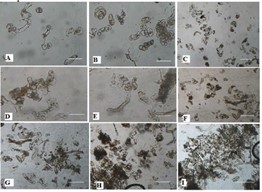
Callus induction and chemical characterization of cell suspension cultures of jojoba (Simmondsia chinensis L.)
Abstract
Keywords
Full Text:
PDFReferences
Aftab, F., S. Akram and J. Iqbal, 2008. Estimation of fixed oils from various explants and in vitro callus cultures of jojoba (Simmondsia chinensis). Pakistan journal of botany, 40(4): 1467-1471.
Ahn, C.-H., A. R. Tull, P. M. Montello and S. A. Merkle, 2017. A clonal propagation system for atlantic white cedar (Chamaecyparis thyoides) via somatic embryogenesis without the use of plant growth regulators. Plant cell, tissue organ culture, 130(1): 91-101.
Duncan, D. R. and J. M. Widholm, 2004. Osmotic induced stimulation of the reduction of the viability dye 2, 3, 5-triphenyltetrazolium chloride by maize roots and callus cultures. Journal of plant physiology, 161(4): 397-403.
Dwivedi, S., A. Alam and G. S. Shekhawat, 2016. Antioxidant response of stevia rebaudiana (bertoni) bertoni (angiosperms; asteraceae) during developing phase of suspension cell culture. Plant science today, 3(2): 115-123.
Kong, E. Y., J. Biddle, M. Foale and S. W. Adkins, 2020. Cell suspension culture: A potential in vitro culture method for clonal propagation of coconut plantlets via somatic embryogenesis. Industrial crops products, 147: 112-125.
Mathur, S. and G. S. J. A. P. P. Shekhawat, 2013. Establishment and characterization of Stevia rebaudiana (bertoni) cell suspension culture: An in vitro approach for production of stevioside. Acta physiologiae plantarum, 35(3): 931-939.
Mikuła, A., M. Niedzielski and J. Rybczyski, 2006. The use of ttc reduction assay for assessment of Gentiana spp. Cell suspension viability after cryopreservation. Acta physiologiae plantarum, 28(4): 315-324.
Mishiba, K. i., T. Okamoto and M. Mii, 2001. Increasing ploidy level in cell suspension cultures of doritaenopsis by exogenous application of 2, 4‐dichlorophenoxyacetic acid. Physiologia plantarum, 112(1): 142-148.
Murashige, T. and F. Skoog, 1962. A revised medium for rapid growth and bio assays with tobacco tissue cultures. Physiologia plantarum, 15(3): 473-497.
Parra, O., A. Gallego, A. Urrea, L. Rojas, C. Correa and L. Atehortúa, 2017. Biochemical precursor effects on the fatty acid production in cell suspension cultures of Theobroma cacao L. Plant physiology biochemistry, 111: 59-66.
Sahraroo, A., M. H. Mirjalili, P. Corchete, M. Babalar and M. R. F. Moghadam, 2016. Establishment and characterization of a Satureja khuzistanica J. (Lamiaceae) cell suspension culture: A new in vitro source of rosmarinic acid. Cytotechnology, 68(4): 1415-1424.
Silva, F.-D. and A. Menéndez-Yuffá, 2006. Viability in protoplasts and cell suspensions of Coffea arabica cv. Catimor. Electronic journal of biotechnology, 9(5): 593-597.
Silver, L. L., 2011. Challenges of antibacterial discovery. Clinical microbiology reviews, 24(1): 71-109.
Tan, S., M. Radzali, A. Arbakariya and M. Mahmood, 2010. Effect of plant growth regulators on callus, cell suspension and cell line selection for flavonoid production from pegaga (Centella asiatica L. Urban). American journal of biochemistry biotechnology, 6(4): 284-299.
DOI: https://doi.org/10.33865/wjb.006.03.0437
Refbacks
- There are currently no refbacks.
Copyright (c) 2021 Muhammad Akram, Faheem Aftab

This work is licensed under a Creative Commons Attribution 4.0 International License.
Print ISSN: 2522-6746 : Online ISSN: 2522-67541. How to register 2. How to reset password2. How to prepare a manuscript before submission 3. How to submit a paper 4. How to check the review status of a paper5. How to check the plagirisim or similarity report